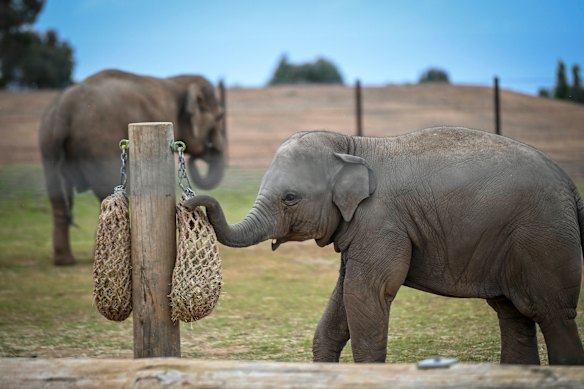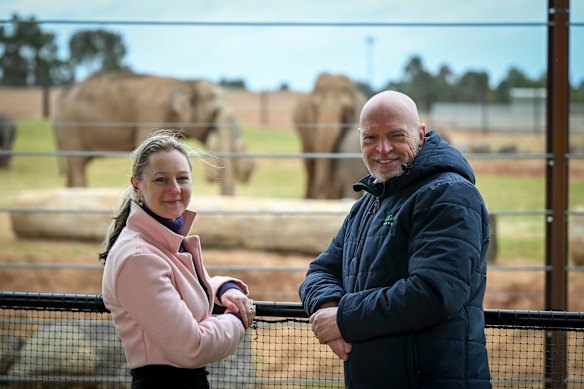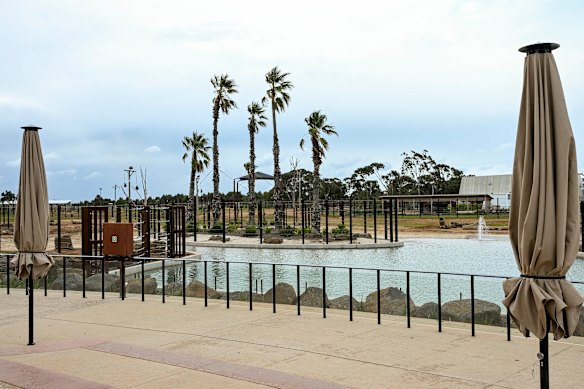By Cara Waters
Palm trees, a beach and swimming pools. But it’s not an island resort – it’s an elephant enclosure in Melbourne’s west.
The 21-hectare site at the Werribee Open Range Zoo, which opened in March and will be showcased as part of Open House Melbourne this weekend, took years to finish.

An elephant calf at the new habitat at Werribee Open Range Zoo. Credit: Eddie Jim
Lisa Howard, director at TCL Architects, said she wanted to design an enclosure that included many of the things elephants interact with and love in the wild.
“It was really about observing and understanding what the animal habits were,” Howard said. “So what do elephants like to do? How can we start to mimic their natural movements in this new environment?”
Howard worked with Zoos Victoria over seven years to come up with features including a barn area to protect the elephants in cold weather, ditches for them to “wallow” in and large piles of sand.
“We all know that they love rolling around in mud and sand,” she said. “So one of the things I wanted was why don’t we just have a giant elephant beach? So you have pools and you have a huge sandpit next to it.”
Howard also focused on the experience for visitors who walk around the habitat through a loop surrounded by about 60,000 plants, including Wollemi pines which go back to the dinosaur era, to highlight elephants’ longevity.
The habitat includes several underpasses where visitors walk in small tunnels underneath the elephants so the animals can move freely between habitats without having to close down the visitor path.
“You can’t put visitors over the top of elephants because there’s an implied superiority there, so what we did was we put the elephants over the humans,” Howard said.
Fencing in the habitat was designed using recycled rail track and elevator cables and subjected to very specific stress testing, specifically being able to withstand a five-tonne male bull elephant running at the fence.

TCL Architects director Lisa Howard and Werribee Open Range Zoo director Dr Mark Pilgrim at the elephant habitat. Credit: Eddie Jim
Werribee Open Range Zoo director Mark Pilgrim said creating a habitat that enables elephants to live as naturally as possible – even if behind a fence – was the key principle guiding the design.
“We wanted the elephants to make decisions, particularly the matriarch, she can now make choices as to where she’s going each day with the herd, where she’s going to take them,” Pilgrim said.
“That’s exactly what a matriarch in a wild herd would be doing, taking the herd to a different area to find food. And that’s pretty groundbreaking.”
Asian elephants in the wild roam across great distances. Research varies, but suggests the herd can travel about 10 kilometres on an average day.

The swimming pool is deep enough for elephants to fully submerge themselves and float.Credit: Eddie Jim
At Werribee, food is placed in different areas of the habitat each day so the elephants have to search as they would in the wild.
Pilgrim moved from the UK to lead the zoo after working in elephant welfare and said there was “huge global interest” in what the zoo had done.
“It’s really raised the bar for elephant welfare across the world,” he said. “It’s not just the open space, it’s what that allows you to do in terms of having different habitats, giving them different activities at different times. So these are hugely intelligent animals and just being able to challenge them on a day-to-day basis is hugely important.”
The habitat was created using an $88 million state government grant and is the same size as the entire Melbourne Zoo site.
Previously the elephants were contained on two hectares of land, space which became even more constrained with the birth of the zoo’s calves.
Howard said she cried when the elephants entered the habitat for the first time and the calves ran to explore their new surroundings.
“I did literally cry … seeing them and hearing them trumpeting and the ears flapping,” she says. “They obviously don’t have facial expressions like humans, but you could tell they were just so excited about it.”
The habitat also includes plenty of room for the elephant herd to expand further if more calves are born.
“Just to stand on the terrace and look out over these pristine waters, beautiful beach landscape and know that you’ve almost created this little paradise for the elephants to live in is extraordinary,” Howard said.
Open House Melbourne runs on July 26-27.
Start the day with a summary of the day’s most important and interesting stories, analysis and insights. Sign up for our Morning Edition newsletter.